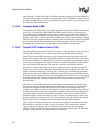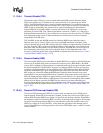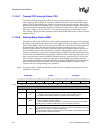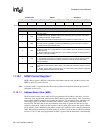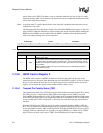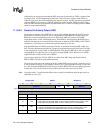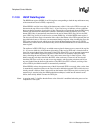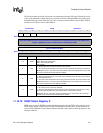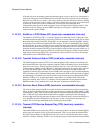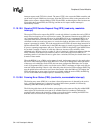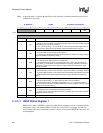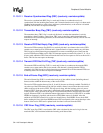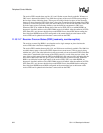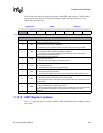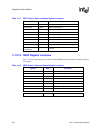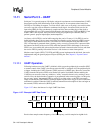
318 SA-1110 Developer’s Manual
Peripheral Control Module
A bit that can cause an interrupt signals the interrupt request as long as the bit is set. Once the bit is
cleared, the interrupt is cleared. Read/write bits are called status bits; read-only bits are called flags.
Status bits are referred to as “sticky” (once set by hardware, must be cleared by software). Writing
a one to a sticky status bit clears it; writing a zero has no effect. Read-only flags are set and cleared
by hardware; writes have no effect. Additionally, some bits that cause interrupts have
corresponding mask bits in the control registers and are indicated in the following sections. Note
that the user has the ability to mask all HSSP interrupts by clearing bit 16 within the interrupt
controller mask register (ICMR).
11.10.10.1 End/Error in FIFO Status (EIF) (read-only, nonmaskable interrupt)
The end/error in FIFO flag (EIF) is a read-only bit that is set when any tag bits (8 through 10) are
set within the bottom eight entries of the receive FIFO and is cleared when no tag bits are set within
the bottom eight entries of the FIFO. When EIF is set, an interrupt is signalled and DMA requests
to empty the receive FIFO are disabled until EIF is cleared. To discover which FIFO entry contains
the end-of-frame or an error condition, the user should check the state of the EOF, CRE, and ROR
bits (described in the following sections), then read the corresponding value from the HSDR. This
procedure should be repeated until EIF is cleared because set flag bits that are present within any of
the eight lowest entries in the receive FIFO can set EIF. Once all tags are cleared from the bottom
eight entries of the receive FIFO, EIF is automatically cleared, which in turn, clears the interrupt
and reenables receive FIFO DMA requests.
11.10.10.2 Transmit Underrun Status (TUR) (read/write, maskable interrupt)
The transmit underrun status bit (TUR) is set when the transmit logic attempts to fetch data from
the transmit FIFO after it has been completely emptied. When an underrun occurs, the transmitter
takes one of two actions. When the transmit underrun select bit is clear (TUS=0), the transmitter
ends the frame by shifting out the CRC that is calculated continuously on outgoing data, followed
by a stop flag and SIP pulse. When TUS=1, the transmitter is forced to transmit an abort and
continues to transmit chips containing all zeros (0000) until valid data is again available within the
FIFO. Once data resides within the bottom entry of the transmit FIFO, a new data frame is initiated
by transmitting 16 preambles and a start flag followed by the transmission of data from the FIFO.
When the TUR bit is set, an interrupt request is made unless it is masked. When TUS=0, the
interrupt is masked; when TUS=1, it is enabled. Note that underruns are not generated when the
HSSP transmitter is first enabled and is in the idle state (continuously transmits flags).
11.10.10.3 Receiver Abort Status (RAB) (read/write, nonmaskable interrupt)
The receiver abort status bit (RAB) is set when an abort is detected during receipt of an incoming
frame. An abort is signalled when two or more chips that do not contain any pulses (0000) or chips
containing 0011, 1001, 1010, or 0101(invalid chips not contained within the stop flag) are detected
after a valid start flag has been detected but before a complete stop flag has been received (an
incorrect chip in the stop flag generates an abort as well). When an abort is received, the EOF tag is
set in the FIFO entry that corresponds to the last piece of data received before the frame was
aborted. The receiver then enters hunt mode, searching for the preamble.
11.10.10.4 Transmit FIFO Service Request Flag (TFS) (read-only, maskable
interrupt)
The transmit FIFO service request flag (TFS) is a read-only bit that is set when the transmit FIFO is
nearly empty and requires service to prevent an underrun. TFS is set any time the transmit FIFO
has eight or fewer entries of valid data (half-full or less), and is cleared when it has nine or more
entries of valid data. When the TFS bit is set, an interrupt request is made unless the transmit FIFO



